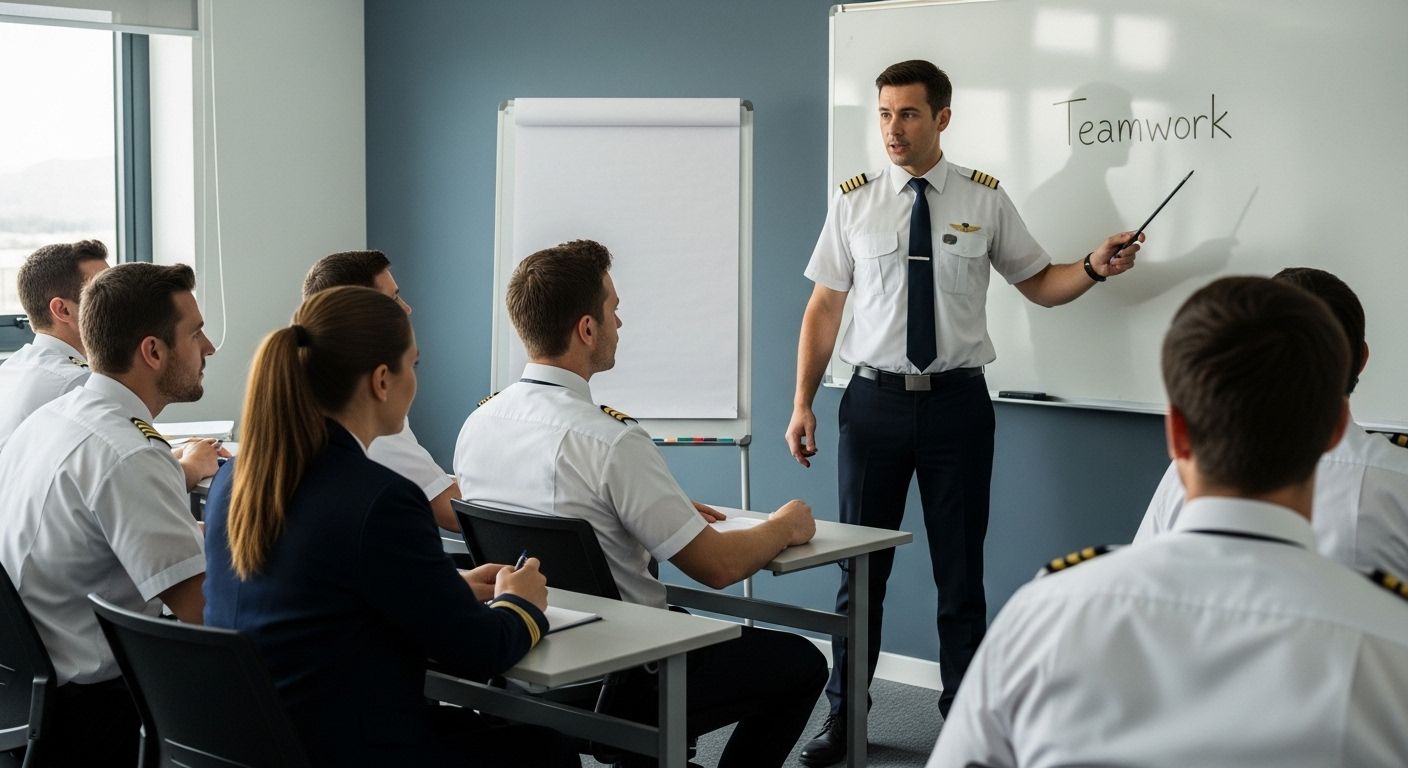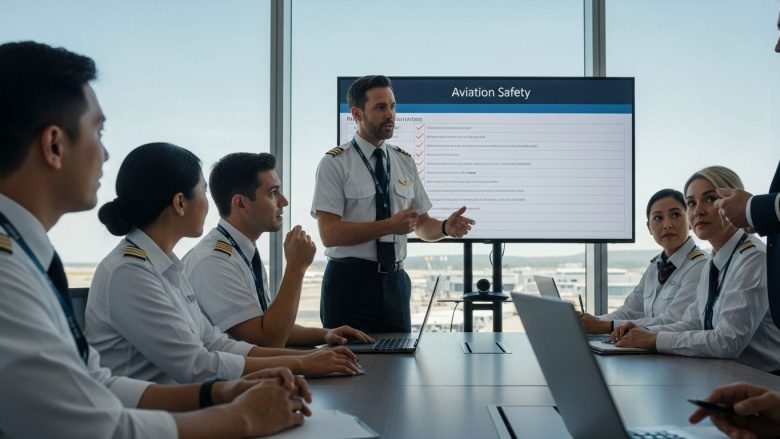Aviation safety hinges on more than just advanced technology and rigorous procedures. Up to 80% of all aviation incidents involve a human factor, not a technical failure. Most people assume that attention to mechanical detail can single-handedly keep us safe in the skies. Yet, the real breakthrough lies in understanding how humans think, decide, and even falter within these complex systems. There is far more to safe flights than meets the eye.
Table of Contents
- What Are Human Factors In Aviation?
- Why Human Factors Matter In Aviation Safety
- How Human Factors Influence Pilot Performance
- Key Concepts In Human Factors: Decision Making And Teamwork
- Real-World Applications Of Human Factors In Aviation
Quick Summary
| Takeaway | Explanation |
|---|---|
| Address Human Error Risks | Understanding human error can prevent approximately 80% of aviation incidents by identifying potential mistakes. |
| Enhance Decision-Making Skills | Train aviation professionals to develop situational awareness and cognitive adaptability for effective decision making under pressure. |
| Collaborate for Safety | Foster teamwork and communication to reduce the 65% of incidents caused by breakdowns in team interactions. |
| Optimise Ergonomic Design | Redesign cockpit interfaces to alleviate cognitive load, enhancing pilot interaction with technological systems. |
| Implement Proactive Training | Comprehensive training can reduce operational errors by up to 50%, addressing human factors effectively. |
What are Human Factors in Aviation?
Human factors in aviation represent a critical interdisciplinary approach to understanding how human performance, limitations, and interactions with complex aviation systems directly impact safety and operational effectiveness. This scientific discipline examines the intricate relationship between human capabilities, technological environments, and organisational processes within aviation settings.
Understanding Human Performance in Aviation Systems
Human factors research focuses on comprehending how pilots, air traffic controllers, maintenance personnel, and other aviation professionals interact with increasingly sophisticated technological systems. The core objective is identifying potential sources of human error, developing strategies to mitigate risks, and designing work environments that optimise human performance.
Key areas of human factors analysis include:
- Cognitive Processing: Examining how humans perceive, decide, and respond in high-stress aviation environments
- Physical Ergonomics: Designing cockpit interfaces and workspaces that align with human physiological capabilities
- Psychological Factors: Understanding stress, fatigue, decision-making processes, and communication dynamics
Practical Applications and Safety Implications
In practical terms, human factors analysis helps aviation organisations prevent accidents by understanding the complex interplay between human capabilities and systemic challenges. Learn more about aviation safety management techniques that incorporate human factors principles.
According to research from the International Civil Aviation Organization (ICAO), approximately 80% of aviation incidents involve some form of human error. This statistic underscores the critical importance of understanding and mitigating human factors risks in aviation operations.

By systematically studying human performance, aviation professionals can develop more effective training programmes, improve communication protocols, and create safer working environments that reduce the potential for human error.
To clarify the types of human factors and their focus areas in aviation, the following table organises each primary area with a brief explanation.
| Human Factor | Focus Area | Explanation |
|---|---|---|
| Cognitive Processing | Perception, decision, response | How individuals perceive situations, decide on actions, and respond, especially under stress |
| Physical Ergonomics | Workspace and interface design | Aligning cockpit layouts and controls with human physiological abilities |
| Psychological Factors | Stress, fatigue, communication | Understanding how mental states, stress, and communication styles impact performance |
| Teamwork | Crew collaboration, communication dynamics | Cooperative strategies and effective communication to enhance group performance |
| Technological Interaction | Human-system interface | How users interact with complex aviation technologies and system feedback |
Why Human Factors Matter in Aviation Safety
Human factors play a pivotal role in aviation safety, serving as a critical mechanism for understanding and preventing potential risks in complex operational environments. By systematically addressing how human performance, psychological states, and technological interactions contribute to safety outcomes, aviation organisations can develop more robust preventative strategies.
The Critical Impact of Human Performance
In aviation, human performance directly influences safety margins. Pilots, air traffic controllers, and maintenance personnel operate within intricate systems where split-second decisions can mean the difference between safe operations and potential catastrophic incidents. Human error is not just an individual failure but a systemic challenge that requires comprehensive understanding and strategic mitigation.
Key reasons human factors are essential in aviation safety include:
- Cognitive Limitation Recognition: Understanding inherent human cognitive constraints and designing systems that compensate for these limitations
- Error Prevention: Developing proactive strategies to identify and mitigate potential human performance risks before they escalate
- Systemic Risk Management: Creating organisational cultures that prioritise safety through continuous learning and adaptive practices
Technological Interaction and Safety Protocols
Explore advanced safety management techniques that integrate human factors principles into operational frameworks. Modern aviation safety increasingly relies on understanding how humans interact with complex technological systems, recognising that technology should complement human capabilities rather than create additional cognitive burdens.
According to research from the UK Civil Aviation Authority, approximately 70% of aviation incidents can be traced back to human factors, underscoring the critical importance of comprehensive human performance analysis.
By continually evolving our understanding of human factors, aviation professionals can create more resilient, adaptive, and ultimately safer operational environments that protect both personnel and passengers.
How Human Factors Influence Pilot Performance
Pilot performance is a complex interplay of psychological, physiological, and cognitive factors that significantly impact aviation safety and operational effectiveness. Understanding these intricate dynamics helps aviation organisations develop targeted strategies to optimise human capabilities and minimise potential performance risks.
Psychological and Cognitive Performance Drivers
The psychological state of a pilot directly influences decision-making, situational awareness, and overall operational competence. Mental resilience and cognitive processing speed are critical components that determine a pilot’s ability to navigate complex, high-stress aviation environments effectively.
Key psychological factors affecting pilot performance include:
- Stress Management: Ability to maintain composure and make rational decisions under intense pressure
- Cognitive Flexibility: Adapting quickly to changing environmental conditions and unexpected scenarios
- Emotional Intelligence: Recognising and managing personal emotional states during challenging situations
Physiological Factors and Performance Limitations
Physiological conditions such as fatigue, sleep deprivation, and physical health significantly impact a pilot’s cognitive and motor capabilities. Learn strategies for managing professional stress in aviation to maintain optimal performance levels.
According to research from NASA’s Human Performance Research Group, prolonged cognitive load and environmental stressors can reduce reaction times and decision-making accuracy by up to 40%, highlighting the critical importance of understanding human performance limitations.
By recognising and addressing these complex human factors, aviation professionals can develop comprehensive training programmes, improve cockpit design, and create supportive organisational cultures that enhance pilot performance and overall aviation safety.
Key Concepts in Human Factors: Decision Making and Teamwork
Decision making and teamwork represent fundamental pillars of human factors in aviation, critically influencing operational safety and organisational performance. These interconnected concepts encompass complex cognitive processes, interpersonal dynamics, and strategic communication that determine how aviation professionals collaborate and respond to challenging situations.
Cognitive Decision Making Processes
Effective decision making in aviation transcends individual capabilities, requiring a sophisticated understanding of cognitive limitations and situational complexities. Pilots and crew members must rapidly process multiple information streams, evaluate potential risks, and select optimal actions under time-sensitive and high-stress conditions.
Key components of aviation decision making include:
- Situational Awareness: Comprehensively understanding environmental conditions and potential threats
- Risk Assessment: Systematically evaluating potential consequences of different action pathways
- Cognitive Adaptability: Quickly recalibrating mental models in response to changing circumstances
Teamwork and Communication Dynamics
Teamwork in aviation represents a critical safety mechanism that goes beyond simple cooperation. Learn essential strategies for effective crew collaboration that enhance overall operational performance and safety protocols.
According to research from the European Aviation Safety Agency (EASA), approximately 65% of aviation incidents can be attributed to communication breakdowns or ineffective team interactions, underscoring the vital importance of robust interpersonal skills.
By developing comprehensive training programmes that emphasise collaborative decision making, communication protocols, and mutual support strategies, aviation organisations can create more resilient, adaptive, and safety-focused operational environments.

Real-World Applications of Human Factors in Aviation
Human factors research translates sophisticated theoretical understanding into practical strategies that directly enhance aviation safety, operational efficiency, and organisational performance. By bridging academic insights with real-world implementation, human factors professionals develop targeted interventions that address complex challenges across different aviation domains.
Technological Interface and Design Optimization
Cockpit design and technological interfaces represent critical areas where human factors principles are directly applied. Modern aviation systems integrate comprehensive ergonomic considerations that help pilots and crew members interact more effectively with increasingly complex technological environments. This approach focuses on reducing cognitive load, minimising potential human errors, and creating more intuitive operational interfaces.
Key practical applications include:
- Instrument Panel Redesign: Developing more readable, logically arranged control displays
- Alarm and Warning Systems: Creating hierarchical alert mechanisms that prioritise critical information
- Interaction Feedback Mechanisms: Designing system responses that provide clear, immediate operational feedback
Organisational Training and Performance Management
Explore advanced crew collaboration techniques that transform theoretical human factors insights into practical training protocols. Aviation organisations increasingly recognise that comprehensive performance management extends beyond individual skill development to include systemic approaches that address team dynamics, communication protocols, and collective decision-making strategies.
According to research from the International Civil Aviation Organization (ICAO), targeted human factors interventions can reduce operational errors by up to 50%, demonstrating the profound impact of strategic implementation.
By continuously integrating empirical research, technological innovations, and adaptive training methodologies, aviation professionals can create more resilient, responsive, and safety-focused operational ecosystems that anticipate and mitigate potential human performance challenges.
The following table summarises key research statistics related to human factors in aviation safety as cited throughout the article.
| Statistic / Source | Percentage / Figure | Context/Explanation |
|---|---|---|
| ICAO – Incidents involving human error | ~80% | Approximate proportion of aviation incidents with a human error element |
| UK Civil Aviation Authority – Incidents traced to human factors | ~70% | Incidents where human factors are a contributing cause |
| NASA Human Performance Research – Impact of cognitive load | Up to 40% decrease | Reduction in reaction and decision accuracy under sustained load |
| EASA – Incidents due to communication breakdowns/team issues | ~65% | Share of incidents where teamwork or communication failed |
| ICAO – Impact of targeted human factors interventions | Up to 50% reduction | Potential decrease in operational errors via comprehensive training |
Take Control of Human Factors in Your Aviation Training
Are you ready to address the real challenges behind pilot error and performance? This comprehensive guide highlights how cognitive limitations, teamwork, and decision making are central to aviation safety. Gaining a deep understanding of these human factors is not only vital for accident prevention but also sets you apart in a competitive industry. At VictorOne.eu, we turn insight into action. Our fully online, EASA-approved pilot theory courses empower you to master real-world applications of human factors—right from your home, anywhere in the world.

Do not let human performance limitations hold you back. Join a learning community that offers flexible study, expertly crafted digital resources, and practical exam support. Discover VictorOne.eu to explore our pilot licensing courses and specialist exam training. Start your journey now to develop the critical skills and professional edge emphasised throughout this guide. Take the next step towards safer skies and a successful aviation career—enrol today.
Frequently Asked Questions
What are human factors in aviation?
Human factors in aviation are an interdisciplinary approach examining how human performance and interactions with technological systems impact safety and operational effectiveness in the aviation environment.
How do human factors influence pilot performance?
Human factors influence pilot performance through psychological, physiological, and cognitive aspects, affecting decision-making, situational awareness, and overall operational competence under stress.
Why are human factors important for aviation safety?
Human factors are critical in aviation safety as they help identify and mitigate risks related to human error, enhance training programmes, and develop systems that accommodate human limitations.
What role does teamwork play in aviation decision-making?
Teamwork is essential in aviation decision-making, as effective collaboration and communication among crew members enhance operational safety and performance, significantly reducing the risk of incidents due to miscommunication.


